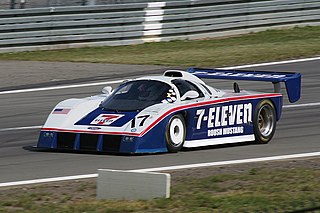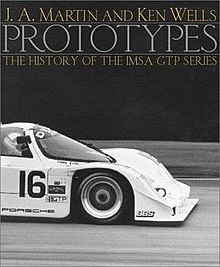
Sports car racing is a form of motorsport road racing which utilises sports cars that have two seats and enclosed wheels. They may be purpose-built (Prototype) or related to road-going models. Broadly speaking, sports car racing is one of the main types of circuit auto racing, alongside open-wheel single seater racing, touring car racing and stock car racing. Sports car races are often endurance races that are run over relatively large distances, and there is usually a larger emphasis placed on the reliability and efficiency of the car than in some of the other types of auto racing. The FIA World Endurance Championship is an example of a sports car racing series.
The International Motor Sports Association (IMSA) is a North American sports car racing sanctioning body based in Daytona Beach, Florida under the jurisdiction of the ACCUS arm of the FIA. It was started by John Bishop, a former executive director of SCCA, and his wife Peggy in 1969 with help from Bill France Sr. of NASCAR. Beginning in 2014, IMSA is the sanctioning body of the WeatherTech SportsCar Championship, the premier series resulting from the merger of Grand-Am Road Racing and the American Le Mans Series. IMSA is owned by NASCAR, as a division of the company.

Group C was a category of motorsport, introduced by the FIA in 1982 and continuing until 1993. Group C applied to sports car racing, with Group A for touring cars and Group B for GTs.
Bernard Jourdain is a Belgian born Mexican racing driver. Jourdain is the uncle of racer Michel Jourdain, Jr., and a pivotal figure in Michel Jr.’s progression from novice to Champ Car race winner. Now retired from racing, Bernard runs a restaurant in California, as well as other business projects.

The 1989 World Sportscar Championship season was the 37th season of FIA World Sportscar Championship motor racing. It featured the 1989 FIA World Sports Prototype Championship, which was open to Group C1 Sports Prototypes, Group C2 Sports Prototypes and IMSA GTP cars. The championship was contested over an eight round series which ran from 9 April to 29 October 1989.

Spice Engineering was a British racing team founded by driver Gordon Spice with Raymond Bellm in the early 1980s, later becoming a successful sports car constructor in 1986. They competed in the World Sportscar Championship in Europe as well as the IMSA GT Championship in North America, at times partnering with major manufacturers such as General Motors and Honda as well as race engine manufacturer Comptech.

IMSA GT was a sports car racing series organized by International Motor Sports Association. Races took place primarily in the United States, and occasionally in Canada.

The Chevrolet Corvette GTP was an American Grand Touring Prototype-class sports prototype racing car which successfully participated in the IMSA Camel GT from 1984 until 1989. The car was professionally fielded in competition as General Motors' Chevrolet Corvette C4 official factory team effort in the IMSA GTP class.

The Mazda RX-792P is a sports prototype racing car built for the IMSA GT Championship's GTP category for Mazda. Its career was short lived, with only two cars running in 1992 before the project was abandoned.
The 1994 Exxon World Sports Car Championship and Supreme GT Series seasons were the 24th season of the IMSA GT Championship. It was the first year for the new World Sports Car (WSC) class of open-cockpit prototypes in the premiere category, replacing the previous closed-cockpit GTP class. Grand Tourer-style racing cars were also raced and ran in the GTS, GTO, and GTU classes. It began February 5, 1994, and ended October 1, 1994, after nine rounds.
The 1993 Camel GT Championship and Exxon Supreme GT Championship seasons were the 23rd season of the IMSA GT Championship auto racing series. It was the final year of the Camel's sponsorship of the prototype class, and the final year of the GTP and Lights prototype categories before they were replaced with the World Sports Car (WSC) class of prototypes the following year. WSC class cars were allowed to participate, but did not score points toward any championships. Grand Tourer-style racing cars were also raced and ran in the GTS, GTO, and GTU classes. An Invitiational GT class was also used for cars which did not comply with IMSA's regulations. It began January 30, 1993, and ended October 3, 1993, after eleven rounds.
The 1991 Camel GT Championship and Exxon Supreme GT Series seasons were the 21st season of the IMSA GT Championship auto racing series. It was for GTP and Lights classes of prototypes, as well as Grand Tourer-style racing cars which ran in the GTO and GTU classes, as well as a tube-frame All-American Challenge (AAC) class during select rounds. It began February 2, 1991, and ended October 13, 1991, after nineteen rounds.

The Lola T600 was a racing car introduced in 1981 by Lola Cars as a customer chassis. It was the first GT prototype race car to incorporate ground-effect tunnels for downforce. The revolutionary aerodynamic design of the T600 was widely imitated throughout the 1980s by International Motor Sports Association (IMSA) and Group C prototype cars. The Lola T600 ran initially in the U.S.-based IMSA GT series and later in European Group C races.
James Downing is an American former professional race car driver, he is a five-time IMSA Championship winner, owner/driver of Downing/Atlanta Racing, and was principal in the development of the HANS device.

The Eagle HF89 and its evolution, the Eagle HF90, is a racing car built and entered by Dan Gurney's All American Racers team, for the IMSA GT Championship. It was raced from 1989 until 1991 in IMSA's premier sports-car racing category, the GTP division. The design was also sometimes called the Eagle MkII.

The Corvette Daytona Prototype is a prototype racing car which started competing in the Rolex series in North America in 2012. It marked Chevrolet's return to Daytona racing as a full constructor and not just as an engine manufacturer. Previously General Motors had competed in Rolex Sports Car Series under the Pontiac brand as well but shelved that program when they discontinued the Pontiac brand for the 2010 season.

The Eagle MkIII is a sports prototype racing car built by All American Racers in 1991 to IMSA GTP specifications. Powered by a turbocharged Toyota inline-4 engine, the car was campaigned in the IMSA Camel GT series by Dan Gurney's Toyota-sponsored AAR team from 1991 through to the end of 1993. The Eagle MkIII won 21 out of the 27 races in which it was entered and is considered one of the most successful and technologically advanced designs of the IMSA GTP era — "a car that proved so overwhelmingly dominant that the class for which it was created has now been assigned to history", according to Racer magazine.

The Intrepid RM-1 is a sports prototype racing car designed in 1991 by Bob and Bill Riley and built by Pratt & Miller to IMSA GTP specifications. Powered by a Chevrolet V8 engine, it was campaigned variously by Jim Miller, Prototype Technology Group and Wayne Taylor in the IMSA Camel GT from 1991 through 1993. Though it won only one race in its three seasons of competition, the shovel-nosed Intrepid was notable for the extreme—and at one point, disastrous—levels of downforce it generated, giving it the highest cornering speeds of any prototype of its era. The car's development was set back by a devastating 1991 crash at Watkins Glen that critically injured driver Tommy Kendall, and the program never fully recovered.

The Ford Mustang Maxum GTP was an IMSA GTP sports racing car designed by Paul Brown and constructed by Maxum Sports Cars. It was operated by Roush Racing during the 1987 season.

The BMW GTP was an IMSA GTP sports racing car built by BMW in 1986. Four March 86Gs were rebuilt by BMW North America into the BMW GTP, and fitted with a Formula One-derived BMW M12/14 turbocharged straight-four engine. Like the F1 cars that used the M12 engine, the BMW GTPs were fragile, and often retired from races; however, when they did complete a race, the BMW GTP was usually classified in the overall top ten. For longevity purposes in endurance races, it usually ran around 800 hp. However, in qualifying trim, 1,400 hp was feasible; combined with the aerodynamics the 220+mph top speed was limited only by gearing. Contemporary car specifications at Le Mans with similar aerodynamics and far less power figures and were surpassing near 250 mph.














